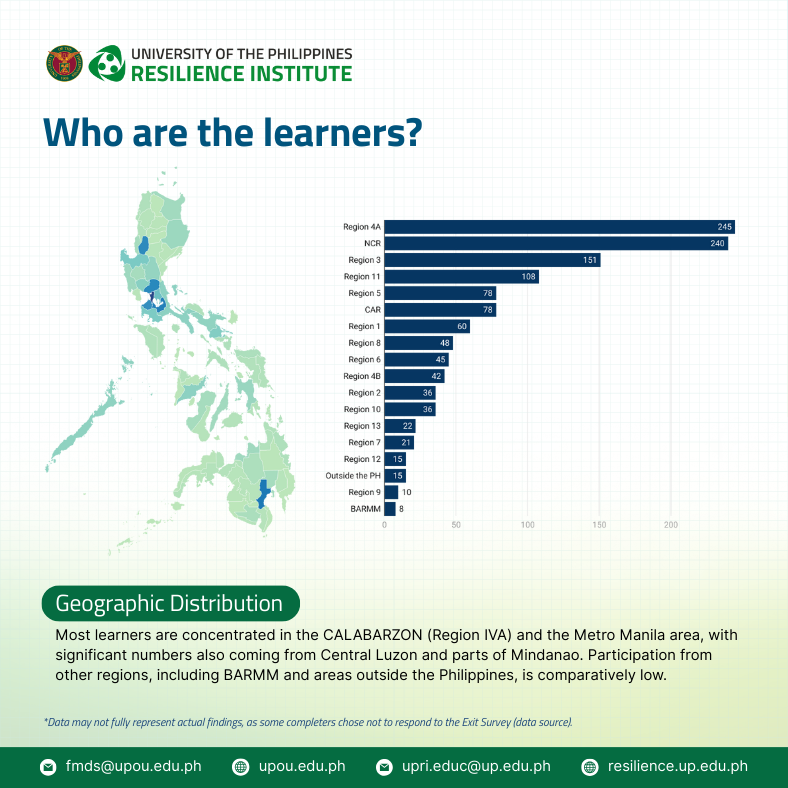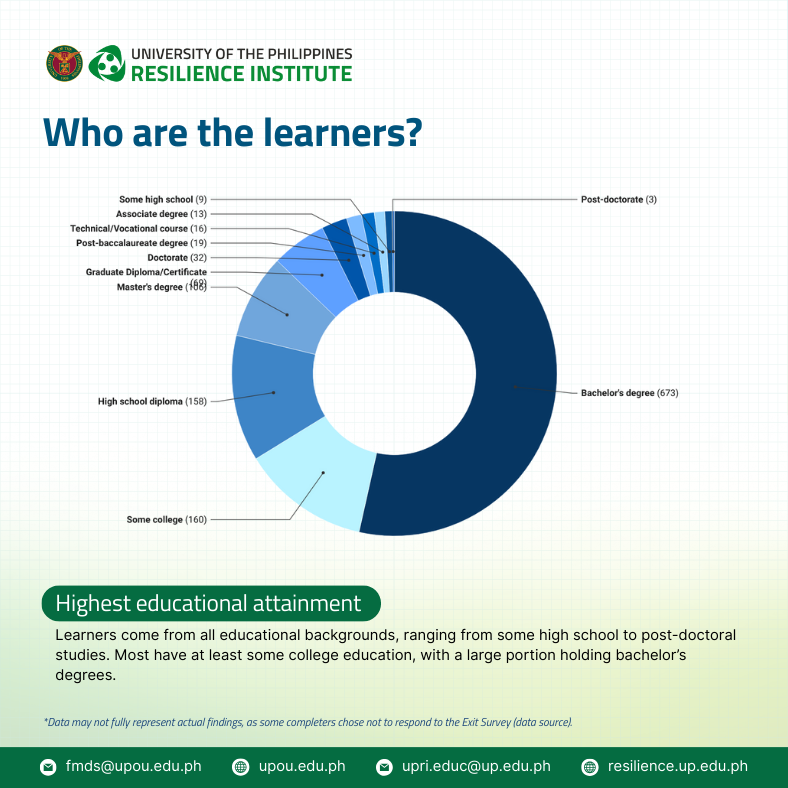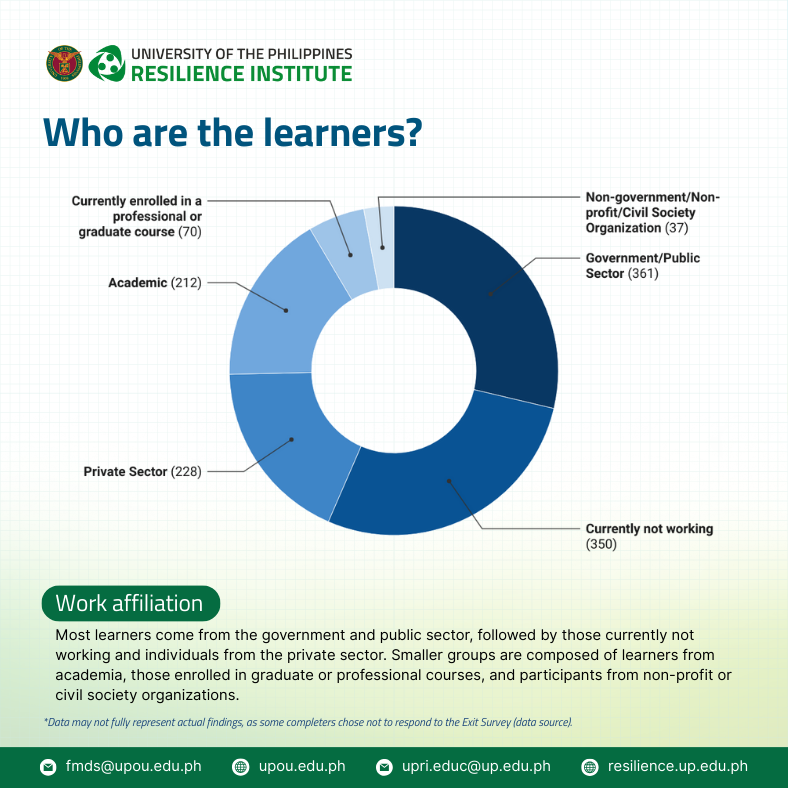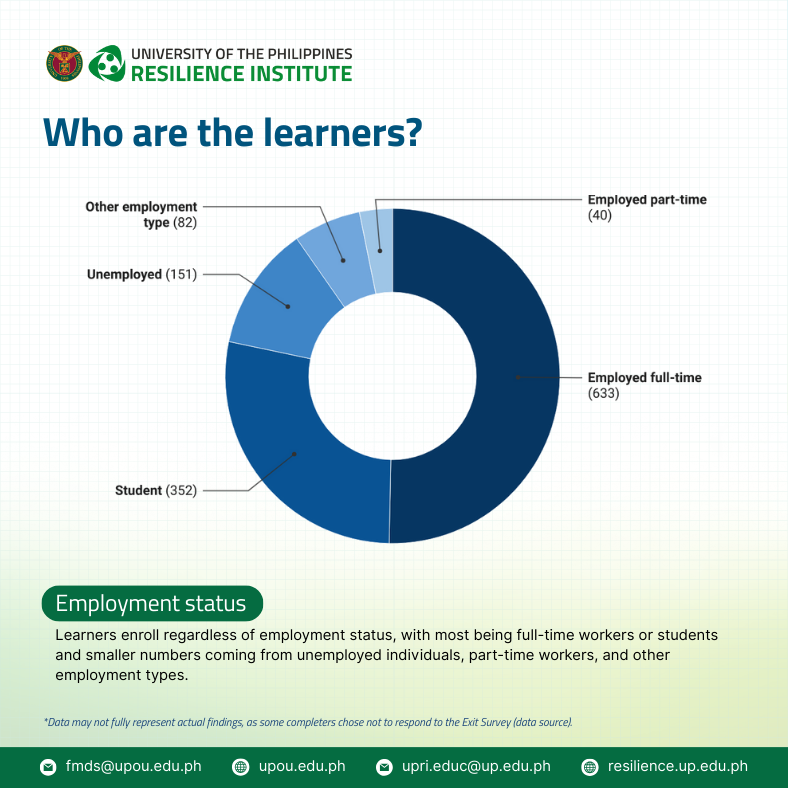by: Evangeline Lucille O. Ortiz, UPRI-Education
While National Disaster Resilience Month has passed, the call of preparedness, safety, and resilience continues, as well as the mission to make disaster knowledge accessible to all.
As part of UPRI and UPOU’s ongoing efforts to build an informed and prepared Filipino community, the Basics of Resilience (BoR) Massive Open Online Courses (MOOCs) continue to provide foundational disaster risk knowledge to learners from all over the country. These free online courses are offered through UPOU’s Massive Open Distance e-Learning (MODeL) platform and cover key concepts in disaster risk reduction and management (DRRM), climate change adaptation, and community-based resilience building.
Since its first launch in 2023, the BoR MOOCs have reached thousands of Filipinos from diverse backgrounds. It aims to provide access to resilience education, with an emphasis on contextualized, science-based, and inclusive learning. Past iterations of the MOOCs have consistently highlighted the wide reach and relevance of these courses, with many learners citing its direct relevance to their professional and community roles.
In celebration of this year’s National Disaster Resilience Month, UPRI relaunched the first two MOOCs of the series from June 16 to July 11, 2025 to renew its commitment to public education and civic engagement around disaster preparedness. In line with the theme, “KUMILOS para sa Kahandaan, Kaligtasan, at Katatagan,” the relaunch reinforces the principle that building resilience is not just a responsibility, but a sustained national effort.
Who are the Learners?
For this past offering of MOOCs 1 and 2, Tthe Basics of Resilience remain accessible to a wide range of participants, reflecting the inclusive nature of resilience education.

Geographically, most participants are concentrated in the CALABARZON (19.5%) and Metro Manila area (19.1%), with a significant number of learners also coming from Central Luzon (12%) and Davao Region (8.6%). The rest of the learners are distributed across the other regions, with smaller but still notable participation from CAR and Bicol (6.2% each) and Northern Luzon areas such as Region I (4.8%). This demonstrates the MOOCs’ reach inside and outside the country while at the same time pointing to opportunities for stronger outreach in underrepresented regions such as BARMM (0.6%) and Region IX (0.8%).

When it comes to educational attainment, the MOOCs have proven valuable both as an entry point for younger learners and as continuing education for advanced professionals.Over half of the participants hold a bachelor’s degree (53.1%), while others come with some college education (12.6%) or a high school diploma (12.5%). Smaller groups include those with technical or vocational qualifications (1.3%), associate degrees (1.0%), and post-doctoral studies (0.2%).

Work affiliation data shows that the largest groups come from the government and public sector (28.7%) and those currently not working (27.8%), followed by the private sector (18.1%). Academia accounts for 16.9% of the participants, while smaller groups include graduate or professional students (5.6%) and representatives from NGOs or CSOs (2.9%). This suggests that while the MOOCs are particularly aligned with government and service-oriented roles, they remain relevant across professional and community-based settings. It also reflects how the courses provide meaningful opportunities for upskilling and personal development even outside formal employment.

The courses also maintain their inclusivity in terms of employment status. While more than half of the learners are employed full time (50.3%), there is still a significant number of students (28%) and unemployed individuals (12.0%) who are able to take and complete the MOOCs. This shows that education on CCA-DRR cuts across professional and personal contexts, allowing individuals at different stages of work and study to build their capacity for disaster preparedness. It reinforces the idea that resilience education is not just sector-specific, but a shared responsibility and resource for all.
Learners’ Voices: Turning Knowledge into Action
Beyond the numbers and statistics, the impact of the Basics of Resilience MOOCs is best reflected in the stories of its learners. Their testimonies reveal how the knowledge gained translates into concrete plans and actions, aligned with this year’s NDRM theme of collective preparedness, safety, and resilience.
For students, resilience education brings lessons that are both urgent and practical. A BS Computer Engineering student from Albay recalled:
“When I was a student at a Polangui boarding house, I was flooded waist deep even during a Signal No. 1. It helped me realize that disasters are still possible at any time. I’ve discovered that having basic strategies, such as assembling emergency kits and safeguarding valuables, knowing where to go in case of an emergency, and being aware of potential hazards may all have a significant impact.”
His story underscores how preparedness begins with individual action, showing that kahandaan is built through everyday habits of safety and awareness.
Knowledge can also translate into practical planning, reinforcing the value of katatagan through informed decision-making. Another student recognized its relevance not only to academics but also to future leadership roles:
“I’d definitely try to incorporate it into my current projects… I can use that framework to analyze the vulnerabilities in my community project proposal… Basically I can use this new knowledge to make my work more effective and efficient.”
Teachers-in-training also see the importance of weaving resilience into learning environments. An aspiring teacher shared:
“The information I learned from this MOOC… enables me to be a responsible member of the community and an active teacher, especially in a disaster-prone nation like the Philippines. I can include disaster risk education into class discussions… plan school-based preparedness exercises like danger mapping or simulation drills.”
Here, preparedness becomes a shared responsibility, ensuring that future generations grow up with both awareness and kaligtasan at the center of their education.
From the frontlines of community service, resilience learning equips leaders to prepare their people. A first responder and community leader reflected:
“The knowledge I gained from this MOOC is extremely valuable, especially in disaster preparedness and risk reduction. Before any calamity occurs, one of the most critical steps is ensuring that all residents living in high-risk or hazard-prone areas are well-informed and prepared.”
This highlights how local leadership plays a critical role in advancing kahandaan and kaligtasan at the grassroots level.
Finally, government officers underscore its institutional value. A Municipal Planning and Development Officer noted:
“I will apply the knowledge from this MOOC by strengthening the integration of hazard and risk assessment into local development and land use planning… and ensuring that programs and infrastructure are designed with risk reduction in mind.”
Such integration ensures that katatagan is embedded in long-term governance, aligning resilience-building with national priorities.
From individual preparedness to community leadership and institutional planning, these testimonies demonstrate how the MOOCs turn resilience knowledge into concrete action. They show that resilience is both personal and collective; a responsibility that every Filipino can carry forward in building safer, stronger communities.
Beyond NDRM
Even as the month of observance has passed,the urgency of its message endures. Much remains to be done to ensure that disaster knowledge reaches the most vulnerable, that risk reduction becomes embedded in local governance and education, and that everyday citizens are empowered to act before, during, and after disasters.
UPRI continues its mandate to make disaster knowledge accessible and actionable, with MOOCs 3 and 4 planned to launch once again this coming October. These courses will build on the foundational knowledge introduced in MOOCs 1 and 2 and will delve deeper into climate and disaster frameworks, policies, and real-world strategies. Those interested in furthering their understanding and capacity for DRRM are encouraged to anticipate the enrollment dates, which will be announced soon on UPRI’s platforms.
For those seeking advanced formal education in the field, UPRI is nearing completion in its development of the Masters in Climate and Disaster Resilience program, also to be offered through UPOU. The program will soon be made available to professionals, practitioners, and scholars aiming to deepen their expertise and leadership in climate and disaster resilience.
Today, as the Philippines confronts severe flooding, environmental degradation, and rising concerns over disaster-response strategies, the theme of NDRM becomes even more pressing. True resilience requires more than commemoration, and thus calls for transparency, science-based planning, and empowered communities actively shaping safer environments.
By sustaining education through MOOCs and advanced education programs, every Filipino is given the chance to take part in this collective mission.
—
Did you miss this offering of the Basics of Resilience?
Catch the next offering of MOOC 3 (Overview of Policies and Strategies for Climate and Disaster Resilience) and MOOC 4 (Resilience Strategies Across the Four Pillars) this October 13 -November 10, 2025. Announcements and updates about the courses will be posted very soon in our social media pages.
The Basics of Resilience MOOC series is also set to relaunch again in 2026, so be ready to set your calendars!
For more information on the Basics of Resilience: https://resilience.up.edu.ph/enroll-in-basics-of-resilience-massive-open-online-course-mooc
